Mission: Impact podcast & blog
Build a better world without becoming a martyr to your nonprofit cause
Listen on:
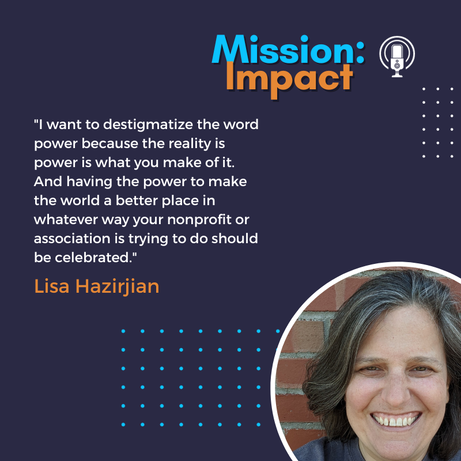 In episode 88, Carol Hamilton interviews Lisa Hazirjian, a historian turned advocate, as they delve into Lisa’s unexpected journey from academia to the forefront of nonprofit advocacy. Through a candid recount of personal challenges and professional transitions, Lisa shares her story, motivations, and the lessons she’s learned along the way. Some of the conversation’s highlights: Motivation for Advocacy: Personal emotions during times of loss and the desire to effect change in public policy were Lisa’s primary motivators to engage in advocacy work. Nonprofit Misconceptions: Lisa corrects the common misconception that nonprofits cannot engage in policy advocacy, stressing that they can and should, as they often hold valuable expertise that can inform policymaking.
Strategic Advocacy: Despite political power dynamics, Lisa argues that effective advocacy is less about which party is in power and more about the ability to influence decision-makers through strategic engagement and communication. Building Relationships: The importance of building relationships before needing to make an ask is highlighted, with suggestions to conduct surveys and use supporters as effective messengers to lawmakers. Volunteer Engagement: Discussion of a “ladder of engagement” approach to progressively involve volunteers in advocacy work, starting with simple actions and building up to higher responsibilities. Training and Responsibility: Emphasizing the need to train volunteers not just for tasks but also for understanding the bigger picture, the narrative includes a personal story demonstrating this practice. Small Wins and Community: Acknowledging small victories and the value of creating a sense of community among advocates is presented as crucial for maintaining motivation and momentum in long-term policy campaigns. For the transcript and more information click here: 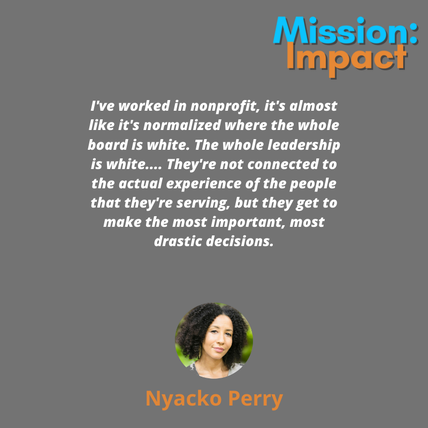 In episode 11 of Mission: Impact, some of the topics that Carol and her guest, Nyacko Perry, discussed include:
Additional Resources:
BoardSource 2017 research on demographics of nonprofit organizations - Leading with Intent report. Guest Information: Nyacko Perry utilizes a systems-thinking approach to assist individuals, community groups, and organizations, in creating more inclusive cultures. Her decade long career as a transformational change agent includes national and international facilitation with non-profit, corporate, and government agencies. Nyacko is the founder of Yin Consulting, a collaborative focused on personal, organizational and systemic healing. She is the Organization Development Partner at the much-anticipated Comfort Kitchen, a restaurant, community meeting space, and a food incubator dedicated to fostering collaboration, cross-cultural understanding, and community engagement. Nyacko also serves as a member of the Advisory Board for the Action Boston Community Development, Inc. Roxbury/N. Dorchester Opportunity Center. Nyacko holds an M.S. in Organization Development, with distinction, from American University. She is also a 500-hour professional level yoga teacher, an Afro Flow Yoga® certified teacher, and weaves her mindfulness expertise into her consulting work. Links:
Click "Read More" for transcript: 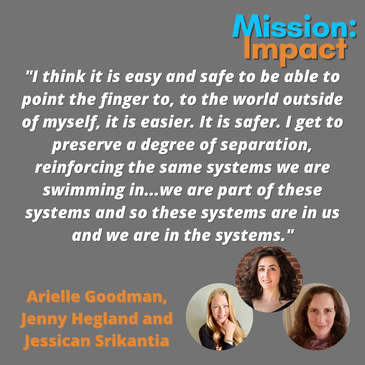 This week we’re talking to Arielle Goodman, Jenny Hegland and Jessica Srikantia. We talked about:
Resources mentioned: Otto Schwarmer and the MIT Presencing Institute www.ottoscharmer.com/ www.presencing.org/ Thomas Huebl thomashuebl.com/ Arielle, Jenny and Jessica are a team of colleagues that has been working together for the past six months to discover how they might be of service as a collective. Their work exists in cultivating the spaces between, such as in-between people during times of transition and not knowing, spaces within our own selves, or the connective tissue of complex systems. Together, they explore what is possible in and from wholeness. They are committed to transforming themselves into alignment with life, so that they can support this work in the broader world inclusive of and beyond their individual selves. Their areas of expertise include navigating uncharted terrain in times of uncertainty, helping systems see and sense themselves, and practicing sacred relationships with team and stakeholder groups. Links: www.linkedin.com/in/jennyhegland www.linkedin.com/in/jessica-srikantia-206797173/ www.linkedin.com/in/ariellegoodman/ Click "Read More" for Transcript: 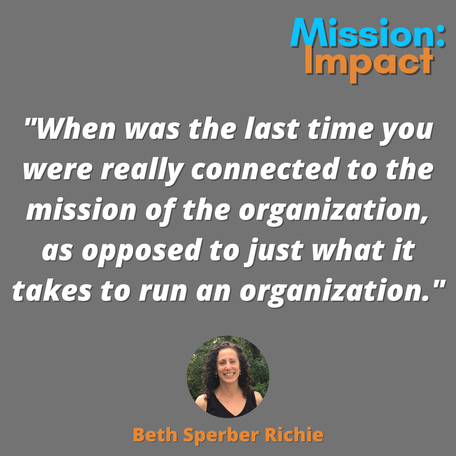 This week we’re talking to Beth Sperber Richie. We talked about: • What is burn out is and why burn out is so prevalent in the nonprofit sector • What the research shows about rest and productivity for organizations. • What vicarious trauma is and how it impacts nonprofit staff and an organization’s culture. Beth Sperber Richie, Ph.D. is a licensed psychologist and consultant in private practice in the Washington, D.C. area. Dr. Richie works with non-profit leaders on how to sustain their staff and their mission given the grind of social change work. She gives workshops and presentations on managing stress and burnout, vicarious trauma and compassion fatigue, improving cross-cultural communication and counseling skills and setting boundaries for front-line employees. Her workshops focus on practical skills and engaged involvement of all participants. Beth on LinkedIn Click "Read More" for Transcript: 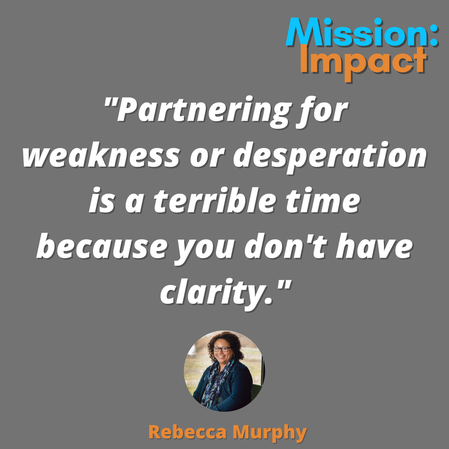 This week we’re talking to Rebecca Murphy. We talked about:
Rebecca has been a consultant for over 20 years. She considers herself an “interpreter,” as she has worked in multiple sectors including government, nonprofit, business, and philanthropy. She is adept at explaining/translating one to another. She is a generalist with a broad knowledge base – including workforce development, affordable housing, parks and place making. She has expertise in capacity building, organizational and program development, strategic planning, with particular expertise in public-private partnerships, community engagement, and strategic collaborations. Hers is a mission-focused practice. She is passionate about mission fidelity, and avoiding mission creep. Links: https://rcmstrategicconsulting.com/ https://twitter.com/RCMStratConsult Click "Read More" for Transcript: |
Archives
April 2024

Grace Social Sector Consulting, LLC, owns the copyright in and to all content in and transcripts of the Mission: Impact podcast, as well as the Mission: Impact blog with all rights reserved, including right of publicity.
|
Telephone301-857-9335
|
info[at]gracesocialsector.com
|
Grace Social Sector Consulting, LLC, owns the copyright in and to all content in, including transcripts and audio of the Mission: Impact podcast and all content on this website, with all rights reserved, including right of publicity.
|